The Mango
The eastern part of Brazil, Trinidad, Venezuela, and the high lands of New Granada.
This familiar species of Humming Bird was not only known to Linneus, but to Ray, Willoughby, Marcgrave, and most of the older authors, and is in fact one of those with which Europeans first became acquainted; nevertheless, much confusion exists with regard to its synonymy, which I believe is principally owing to a nearly allied species, the Lampornis porphyrurus of Jamaica, having been confounded with it.
This bird then it must be understood never goes to Jamaica, and to but few of the West India Islands; on the mainland, however, it enjoys a more extensive range than any other species. Audubon has included a figure of it in his great work on the “Birds of North America,” taken from a specimen said to have been killed in Florida; but I have never yet received examples of the bird from any locality approximating to the northern regions of America, nor from any district to the northward of Costa Rica: on the other hand, it is very generally dispersed over the southern continent for many degrees of latitude along the Andes. I possess examples from Bogota, Guayaquil, Peru, the Caraccas, the Guianas, the Delta of the Amazon, and all parts of Brazil, as far south as the latitude of Rio de Janeiro, in all of which countries it is to be found wherever localities suited to its habits occur. Slight differences of colouring are observable in examples from very distant localities, but none of sufficient importance to warrant their being characterized as distinct. The specimens which exhibit the greatest difference are those from Guayaquil, some of those I possess having the black of the throat washed with a somewhat glittering blue. The great variation which occurs between the colouring of the sexes and the youthful birds at different ages has occasioned an amount of confusion with regard to the synonymy of this species, which it is almost impossible to unravel, and in the investigation of which I have received much valuable assistance from M. Bourcier, of Paris, who has kindly sent me a list of all the synonyms which, in his opinion, are referable to this species, and which, with a few others, are given above. I am also indebted to this gentleman for the following note respecting the range of the bird, &c.:—
This Humming Bird, though one of the most widely spread members of its family, is only to be met with in hot localities, and wherever it occurs in the interior of a country it is invariably in the very warm valleys. In its disposition it is wild and quarrelsome; for although it lives in societies, several being always found together, it is continually engaged in fighting with its companions, and in driving away all other birds which approach the tree in which it is breeding. It inhabits Bolivia, Peru, Ecuador, Panama, New Grenada, La Trinité, Guiana, and Brazil. The adult does not assume its perfect plumage until the end of the second year, and in the interval passes through so many changes of plumage, that the variety of appearance it presents has given rise to the various names under which the bird has been described.
I have obtained examples of this species in the province of Manabi, and have killed many in the vicinity of Guayaquil during the rainy season, when I always found there were four or five young birds for every old one. Although this species occurs in such distant localities, there is no great variation in the plumage of the adults. Those obtained in Bolivia are a trifle the largest, and have the bands of green and blue at the sides of the neck a little less brilliant; in fact, the hotter the climate in which the bird dwells, the more brilliant is its general appearance; the black of the throat is more intense, the green of the back and rump is finer, and the violet of the tail more lustrous. Its flight is very rapid.
Mr. Reeves informs me that in Brazil the Lampornis Mango is to be found in Rio de Janeiro, Minas Geraes, St. Paul’s, Santa Catharina, and Para; that it frequents the gardens as well as the forests, and is very common at Rio in some seasons, and equally scarce at others.
The nest is a round cup-shaped structure, placed near the extremity of a small horizontal branch, and is composed of cottony or any similar materials that may be at hand, bound together with cobwebs and ornamented with numerous small pieces of lichens: the eggs as usual are white and two in number, somewhat more than half an inch long, by three-eighths of an inch in breadth.
The adult male has the head, all the upper surface, wing- and tail-coverts, and flanks golden or coppery green; wings purplish brown; two centre tail-feathers bronzy green; lateral tail-feathers chestnut with violet reflexions, and narrowly margined with dark steel-blue; under surface velvety black, separated from the golden green of the upper surface by a band of shining blue, which extends from the corner of the mouth down each side of the neck and breast; under tail-coverts violet-brown in some specimens, glossy green in others; bill and feet black.
The female has the head, upper surface, wing- and tail-coverts, and flanks as in the male; breast and abdomen white, with a broad stripe of black down the centre of the throat, and a similar mark down the centre of the abdomen; in some specimens these marks unite, and form a broad black mark down the middle of the under surface; under tail-coverts green fringed with grey; two centre tail-feathers bronzy green; the next on each side bronzy green, deepening into black at the extremity and slightly fringed with white at the tip; the next on each side similar, but with an obscure mark of chestnut between the green and the black; the two outer feathers bronzy green at the base, then chestnut with violet reflexions, black towards the extremity and slightly tipped with white.
The young male is similar to the female, but has the white on each side the neck suffused with chestnut.
At a very young age the upper surface is bronzy green; the under surface white, spotted down the sides of the neck and body with chestnut-red, the spots being arranged in a double line from the angle of the lower mandible, and leaving a line of white running between them and the eye.
The Plate represents a male, a female, a young bird, and a nest, all of the natural size. The plant is the Solanum fragrans.
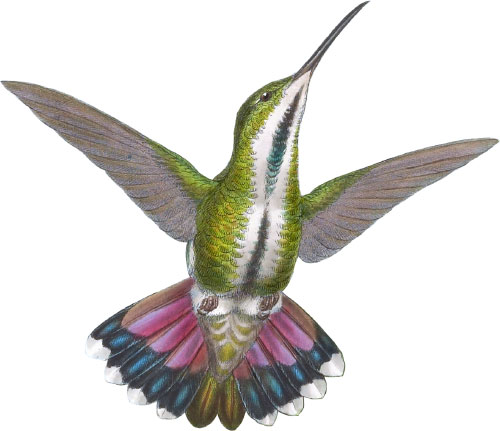 Lampornis Prevosti
Prevost’s Mango
Lampornis Prevosti
Prevost’s Mango
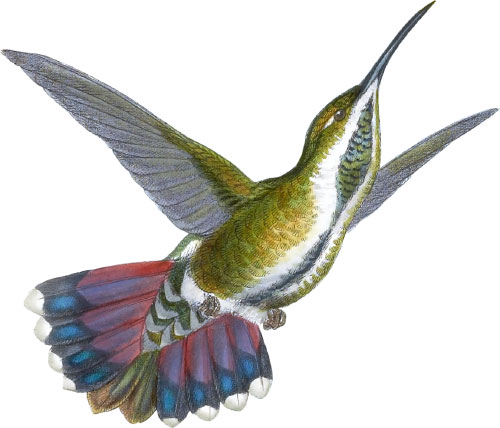 Lampornis Veraguensis
Veraguan Mango
Lampornis Veraguensis
Veraguan Mango
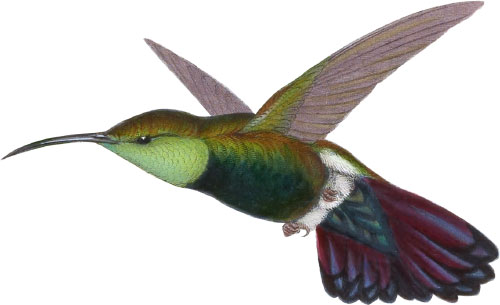 Lampornis gramineus
Green-throated Mango
Lampornis gramineus
Green-throated Mango
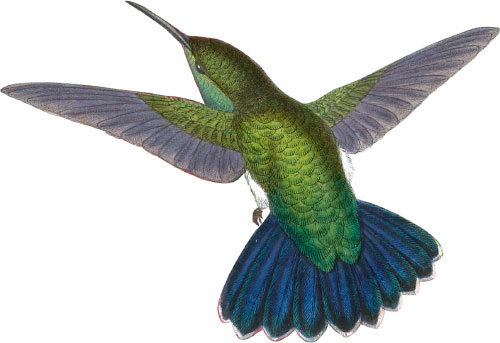 Lampornis viridis
Blue-tailed Mango
Lampornis viridis
Blue-tailed Mango
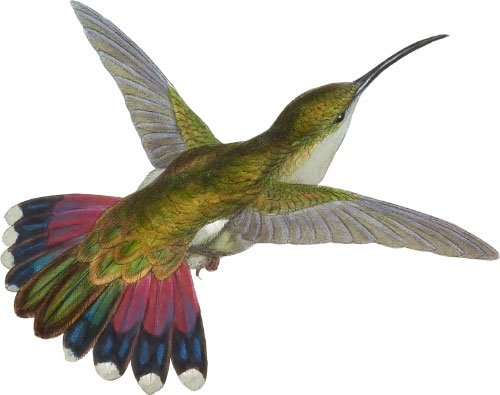 Lampornis aurulentus
St. Domingo Mango
Lampornis aurulentus
St. Domingo Mango
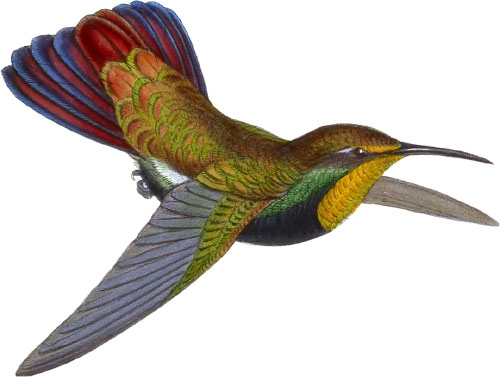 Lampornis virginalis
St. Thomas’s Mango
Lampornis virginalis
St. Thomas’s Mango
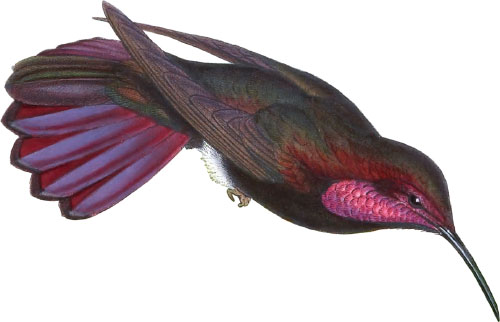 Lampornis porphyrurus
Porphyry-tailed Mango
Lampornis porphyrurus
Porphyry-tailed Mango
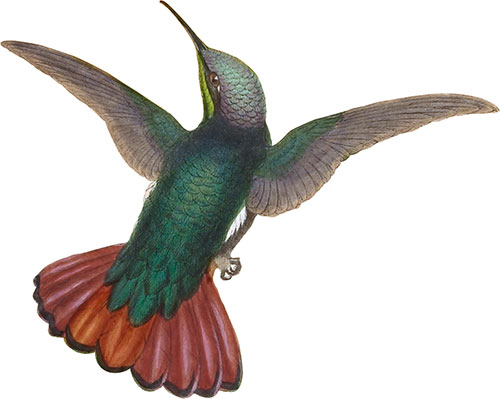 Lampornis calosoma
Elliot’s Topaz
Lampornis calosoma
Elliot’s Topaz
Featuring all 422 illustrated species from John Gould’s A Monograph of the Trochilidæ, or Family of Humming-Birds arranged by color.